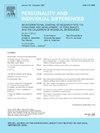High self-esteem discrepancy and low implicit self-esteem are associated with facial rejection bias
IF 2.6
2区 心理学
Q1 PSYCHOLOGY, SOCIAL
引用次数: 0
Abstract
Humans are sensitive to facial acceptance and rejection cues but often exhibit biases when they interpret ambiguous facial cues. While self-reported self-esteem (SE) is known to influence social cue perception, the roles of Explicit Self-Esteem (ESE), Implicit Self-Esteem (ISE) or Self-Esteem discrepancy size (SEDS: absolute difference between standardised ESE and ISE) in interpreting ambiguous facial expressions of acceptance (happiness) and rejection (disgust) are yet to be defined. In two novel studies, ESE and ISE were measured via a self-report questionnaire and an implicit association test, respectively. Social anxiety and the age of the observer were controlled for in the current design. Study 1 (N = 297) used multiple facial identities, whereas Study 2 (N = 98) employed an average facial identity, testing the task's sensitivity in revealing emotion interpretation biases. Additionally, Study 2 introduced an SE threat task to explore whether these biases were modulated by performance feedback. The results of the hierarchical multiple regression revealed that ISE and SEDS significantly predicted emotion interpretation; as ISE decreased and SEDS increased, more faces were interpreted as disgusted rather than happy. These findings suggest that low ISE and high SEDS may contribute to a negative perception bias, with implications for navigating social environments.
高自尊差异和低内隐自尊与面部拒绝偏见相关
人类对面部的接受和拒绝线索很敏感,但当他们解释模棱两可的面部线索时,往往会表现出偏见。虽然已知自我报告自尊(SE)会影响社会线索感知,但外显自尊(ESE)、内隐自尊(ISE)或自尊差异大小(SEDS:标准化ESE与ISE之间的绝对差异)在解释模棱两可的接受(快乐)和拒绝(厌恶)面部表情中的作用尚未明确。在两项新的研究中,分别通过自我报告问卷和内隐联想测验来测量ESE和ISE。在当前的设计中,社会焦虑和观察者的年龄被控制。研究1 (N = 297)使用多种面部身份,而研究2 (N = 98)使用平均面部身份,测试任务在揭示情绪解释偏见方面的敏感性。此外,研究2引入了一个SE威胁任务来探讨这些偏差是否被绩效反馈调节。层次多元回归结果显示,ISE和SEDS对情绪解释有显著的预测作用;随着ISE的降低和SEDS的增加,更多的面孔被解释为厌恶而不是快乐。这些发现表明,低ISE和高SEDS可能会导致消极的感知偏差,并对社交环境的导航产生影响。
本文章由计算机程序翻译,如有差异,请以英文原文为准。
求助全文
约1分钟内获得全文
求助全文
来源期刊

Personality and Individual Differences
PSYCHOLOGY, SOCIAL-
CiteScore
8.50
自引率
4.70%
发文量
577
审稿时长
41 days
期刊介绍:
Personality and Individual Differences is devoted to the publication of articles (experimental, theoretical, review) which aim to integrate as far as possible the major factors of personality with empirical paradigms from experimental, physiological, animal, clinical, educational, criminological or industrial psychology or to seek an explanation for the causes and major determinants of individual differences in concepts derived from these disciplines. The editors are concerned with both genetic and environmental causes, and they are particularly interested in possible interaction effects.
 求助内容:
求助内容: 应助结果提醒方式:
应助结果提醒方式:


